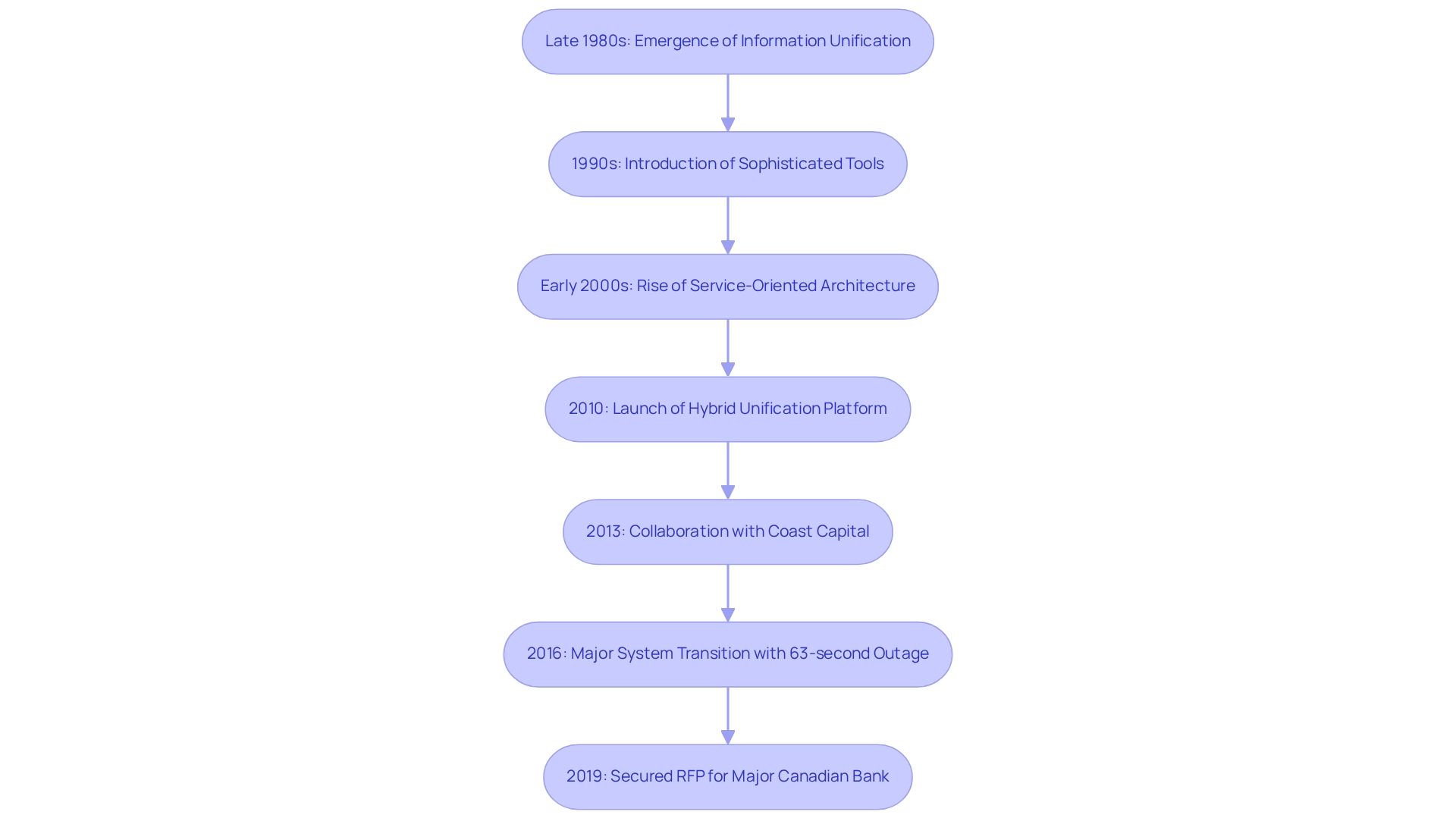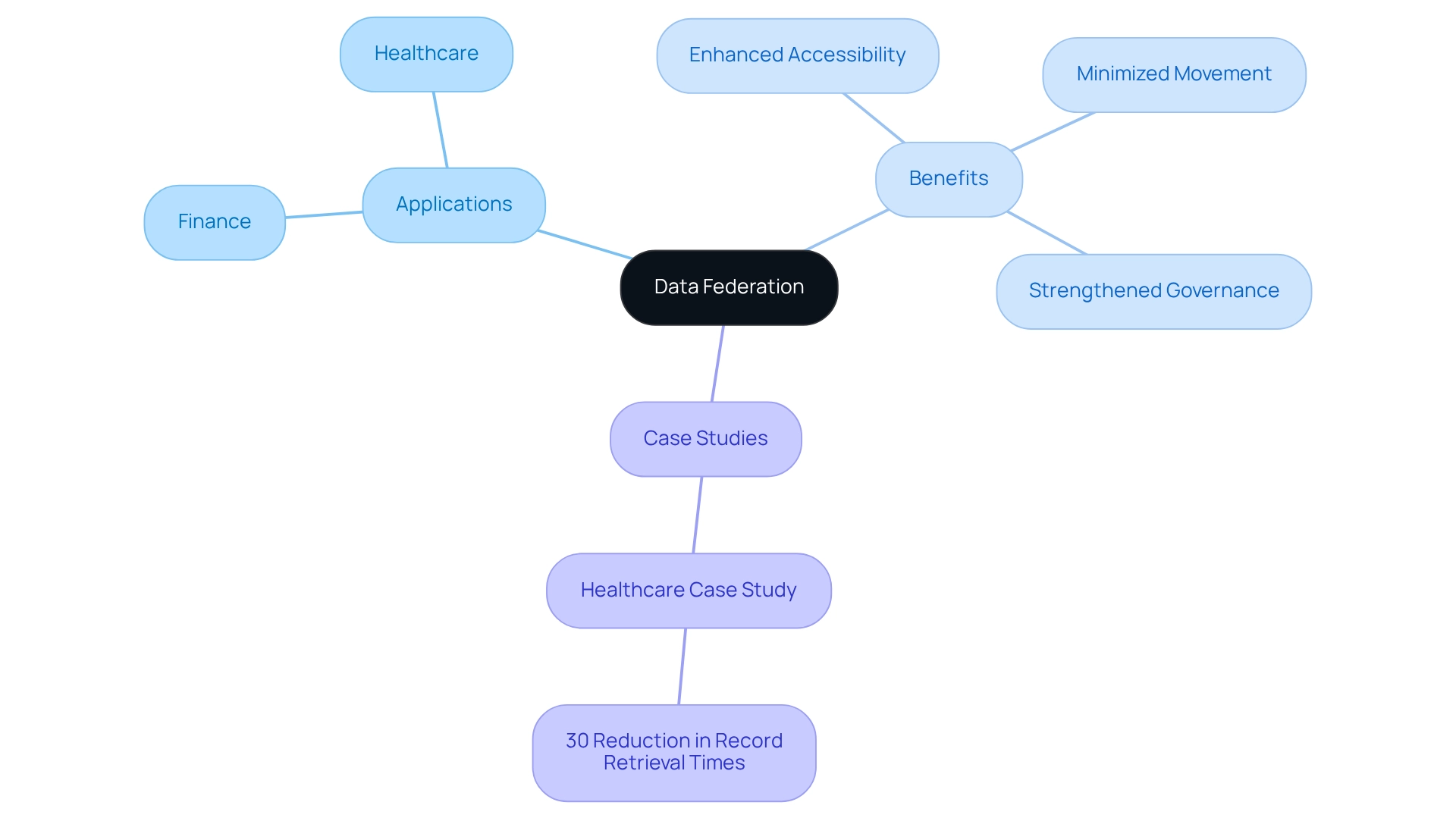Overview
Data federation represents a transformative approach that empowers various databases to function as a cohesive virtual entity. This allows us to access diverse information sources without the need for physical consolidation. We understand the critical importance of enhancing data accessibility, reducing redundancy, and supporting real-time decision-making. This is particularly vital in sectors like banking and healthcare, where operational efficiency and compliance are paramount. As we navigate these challenges, we recognize that leveraging data federation can significantly enhance our operational capabilities.
Introduction
In a world increasingly driven by data, we recognize that organizations are constantly seeking innovative ways to harness information from diverse sources. Data federation emerges as a powerful solution, enabling disparate databases to function as a cohesive unit without the need for physical consolidation. This technique not only simplifies the complexities of managing various data systems but also enhances accessibility and supports real-time decision-making.
As we navigate the challenges of integrating data across cloud platforms, on-premises databases, and legacy systems, the significance of data federation becomes even more apparent. With advanced integration platforms, such as Avato’s hybrid solution, we can unlock the full potential of our data assets, driving operational efficiency and maintaining a competitive edge in today’s fast-paced digital landscape.
What’s holding your team back from achieving this potential? Let us partner with you to explore the transformative power of data federation.
Define Data Federation: Core Concepts and Significance
Information unification is not just an advanced integration method; it is a transformative approach that enables several databases to operate as one cohesive virtual database. This capability allows us to access and query information from diverse sources without the need for physical consolidation, thereby creating a unified view of knowledge. As we look to 2025, the significance of information integration becomes even clearer, especially in addressing the complexities of managing disparate information systems across cloud platforms, on-premises databases, and legacy systems.
The importance of information unification in modern information management cannot be overstated. It enhances information accessibility, reduces redundancy, and supports real-time decision-making—making it essential for organizations like ours that aim to leverage resources effectively. Current statistics reveal that data federation tools are designed to seamlessly incorporate new repositories or applications into existing data landscapes, reflecting a growing trend in enterprise adoption.
At Avato, our hybrid unification platform plays a pivotal role in this landscape by maximizing and extending the value of legacy systems. We simplify complex integrations, significantly reduce costs, and provide real-time monitoring and alerts on system performance. This is particularly beneficial for sectors such as banking, healthcare, and government, where operational reliability is paramount.
Practical examples illustrate the impact of information integration on operational efficiency. In the banking sector, for instance, organizations that have embraced information consolidation report enhanced information management capabilities, enabling them to respond promptly to regulatory changes and client needs. A notable case study titled “Response Time and Lifecycle in Breaches” underscores that organizations employing information integration experience significantly lower costs associated with breaches, as they can identify and react to incidents more swiftly, with an average detection time of 204 days for breaches.
Expert opinions further validate the meaning of data federation and its value. Industry leaders emphasize that the ability to combine and oversee information from various sources is crucial for maintaining a competitive advantage in today’s information-driven environment. As Ernest Dimnet aptly stated, “Our potential for innovation, problem-solving, and growth is only as good as the information we gather and, most importantly, utilize.” The consensus is clear: entities that effectively leverage information integration, supported by our dedicated hybrid platform, are better positioned to innovate and tackle challenges, ultimately fostering growth and success in their respective markets. However, we must also acknowledge the challenges inherent in information integration, including query performance overhead, latency issues, and security and governance complexities, which we must navigate to fully realize its benefits.
Trace the Evolution of Data Federation: Historical Context and Development
The concept of information unification emerged in the late 1980s as organizations faced increasing challenges in synthesizing insights from diverse sources. Early techniques, such as Enterprise Information Integration (EII), were developed to address these complexities. As technology advanced, particularly with the advent of cloud computing and large-scale information, the landscape of information integration underwent a significant transformation. Today, we leverage contemporary information aggregation systems that utilize advanced middleware solutions, enabling seamless querying across various sources. This evolution empowers us to maintain agility and responsiveness in an ever-changing information environment.
The historical trajectory of information integration reveals several pivotal milestones. In the 1990s, the introduction of more sophisticated information unification tools marked a critical turning point, enhancing access and management capabilities. By the early 2000s, the emergence of service-oriented architecture (SOA) further augmented data federation, allowing us to integrate disparate systems with greater efficacy.
A notable case study illustrating this evolution is our hybrid unification platform, successfully deployed across various financial institutions since its launch in 2010. For example, our collaboration with Coast Capital, which went live in February 2013, demonstrates how our solutions facilitate significant system transitions with minimal downtime—exemplified by a mere 63-second outage during a major switch in 2016. This capability underscores our commitment to delivering speed and reliability in integration processes.
Our platform supports 12 levels of interface maturity, showcasing the complexity and sophistication of modern information integration systems. As organizations increasingly adopt cloud solutions, the impact of cloud computing on information integration has become profound, allowing real-time access to up-to-date information while minimizing duplication. Gustavo Estrada, one of our clients, remarked, “Avato has the capability to streamline intricate projects and provide outcomes within specified time limits and budgetary restrictions,” highlighting the importance of efficient coordination strategies. In 2019, we secured an RFP for a major schedule-one Canadian bank, further validating our capabilities within the financial sector. Overall, the advancement of our information aggregation methods reflects an ongoing commitment to simplifying integration processes, ensuring that enterprises can optimize their assets effectively and maintain a competitive edge in their industries.

Examine Key Components of Data Federation: Mechanisms and Processes
The essential elements of our information unification architecture comprise the unification engine, metadata oversight, and information source connectivity. Our federation engine serves as a middleware layer, efficiently processing user queries and coordinating information retrieval from diverse sources. This functionality is critical, particularly as organizations anticipate a projected 25% annual growth in analytics skills, underscoring the need for robust integration solutions. As Ernest Dimnet wisely remarked, “Our capacity for innovation, problem-solving, and growth is only as effective as the information we gather and, most importantly, apply.” This insight highlights the crucial role of information utilization in driving business success.
We recognize that metadata management plays a vital role in maintaining context and ensuring information quality, which is essential for effective decision-making. It empowers organizations to monitor information lineage and comprehend the connections between various information elements. In addition, our information source connectivity creates virtual links to both relational and non-relational databases, enabling seamless access to a broad range of information types.
Together, these components form a cohesive access layer that simplifies querying and enhances integration efforts. Our architecture not only facilitates real-time access to information but also minimizes duplication, ensuring that users can work with the most current details available. As organizations increasingly adopt multi-cloud strategies, the significance of data federation within a well-structured information federation system becomes even more pronounced.
Moreover, incorporating XSLT into this architecture can significantly enhance XML content transformation processes, allowing for efficient handling and unification. The declarative nature of XSLT simplifies complex transformations, making it easier for us to maintain and extend integration solutions. Additionally, the use of schemas within Avato’s Hybrid Integration Platform ensures structured data management, leading to compliance and reduced programming errors, ultimately driving cost savings for our clients. Features such as real-time monitoring and alerts on system performance further enhance our platform’s capabilities, ensuring that organizations can adapt to changing needs and future-proof their systems.
Case studies showcasing the results of Avato’s hybrid unification platform illustrate that the successful execution of collaborative engines can yield considerable cost savings and enhanced customer satisfaction.
Explore Applications and Benefits of Data Federation: Enhancing Data Access and Integration
Information unification is essential across various sectors, particularly in finance and healthcare, as it significantly enhances access and integration. In banking, we utilize information integration to consolidate risk-related details from diverse sources, thereby facilitating more informed decision-making. The benefits of this integration are extensive:
- It enhances accessibility
- Minimizes unnecessary movement
- Strengthens governance
By enabling users to query multiple information sources as if they were a unified collection, we simplify analytics processes, greatly reduce operational expenses, and improve overall information quality. Moreover, information aggregation aids in adhering to privacy regulations by allowing sensitive information to remain at its origin while providing regulated access to authorized users.
In healthcare, the application of information integration is equally transformative. For instance, healthcare providers can combine patient information from various systems, leading to improved patient outcomes through better-informed clinical decisions. A significant case study illustrates how a healthcare organization employed information integration to unify patient records from multiple systems, resulting in a 30% reduction in record retrieval times and enhanced care coordination. This case exemplifies how our hybrid integration platform supports such initiatives by offering a reliable, future-proof technology stack that enhances operational capabilities and accelerates secure system integration for banking, healthcare, and government.
Statistics indicate that the demand for analytics expertise is projected to increase by 25% annually, underscoring the importance of efficient information management strategies like information integration in navigating the evolving landscape of digital transformation. As Don Terry, Chief Revenue Officer, stated, “We’re thrilled to expand the transformative capabilities of generative AI and integrate technologies like watsonx.ai into our solutions to securely deliver improved and automated analysis and culling.” By embracing information unification, we empower financial institutions and healthcare entities to not only enhance their operational capabilities but also prepare for future challenges and opportunities. This ultimately revolutionizes business integration with hybrid solutions for legacy systems in regulated sectors.
To learn more about how we can help your organization leverage data federation for improved efficiency and compliance, we invite you to explore our solutions today.

Conclusion
Data federation is not just a tool; it is a cornerstone of modern data management that empowers organizations to integrate diverse data sources into a unified framework. By facilitating access to information across cloud platforms, on-premises databases, and legacy systems without the need for physical consolidation, we enhance data accessibility and support real-time decision-making. This strategic approach reduces redundancy and fosters operational efficiency, especially in critical sectors like banking and healthcare, where timely access to accurate data is paramount.
The evolution of data federation showcases significant technological advancements, moving from early integration techniques to sophisticated middleware solutions that enable us to remain agile in a rapidly changing environment. Our hybrid integration platform exemplifies this evolution, offering robust tools for seamless data access and integration while minimizing disruption and costs. Real-world case studies highlight the tangible benefits of data federation, such as improved response times to regulatory changes and enhanced patient care through unified health records.
As we navigate growing data demands, the importance of a well-structured data federation system cannot be overstated. By effectively managing and utilizing our data assets, we can drive innovation and problem-solving while maintaining a competitive edge. Embracing data federation is not merely a strategic choice; it is an essential step toward harnessing the full potential of data in today’s digital landscape, paving the way for future growth and success. What steps will you take to ensure your organization fully leverages the power of data federation?

